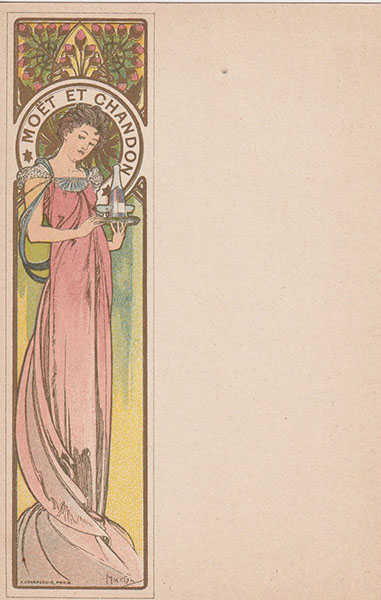Mucha, Alphonse
1860 – 1939
Czech
Born in Moravia, in the former Austro-Hungarian Empire, Alphonse Mucha was actually denied admission to the Prague School of Fine Art and ended up in Vienna painting theatrical scenery for a living. Soon after he earned a commission painting the decorations for the game room of Emmahof Castle in Mikulov for the Count Karl Khuen-Belassi. As luck would have it, the Count was so impressed with Mucha’s work that he became his patron, financing his art studies at the Munich Academy of Fine Art and eventually at the Académie Julien and Académie Colarossi in Paris.
Once more, the hand of fate stepped in and with the suicide of the Count in 1887 Mucha was again in need of support. He turned to book and magazine illustration and eventually had the good fortune to meet the Divine Sarah Bernhardt. It was his poster design for her “Gismonda” at the Théâtre de la Renaissance that made him famous almost overnight. Sarah Bernhardt signed a 6-year contract with Mucha to design more posters, scenery and costumes and even jewelry, and the results are among the most highly coveted and beautiful Art Nouveau images ever created.
In 1904 Alphonse Mucha was invited to teach at the Art Institute of Chicago and for a period of six years he divided his time between Paris and the United States. He contributed to such French publications as “La Vie poplulaire”, “L’Estampe Moderne”, “L’Illustration”, and most notably “La Plume”. He illustrated many books including “Le Pater”, “L’Ilsée Princesse de Tripoli”, and the albums “Documents Décoratifs” and “Figures Décoratifs”. He also created a significant body of work in the form of calendars, post cards, menus and programs, all in his archetypal Art Nouveau style.
He returned to his homeland in 1910 and committed himself to painting a series of historical compositions based on the Slav Epic. This massive undertaking took 17 years to complete. When Czechoslovakia was invaded in 1939 he was arrested by the Gestapo but later released. He died shortly afterward.
Mucha’s name remains synonymous with the florid elegance of the Art Nouveau movement.

